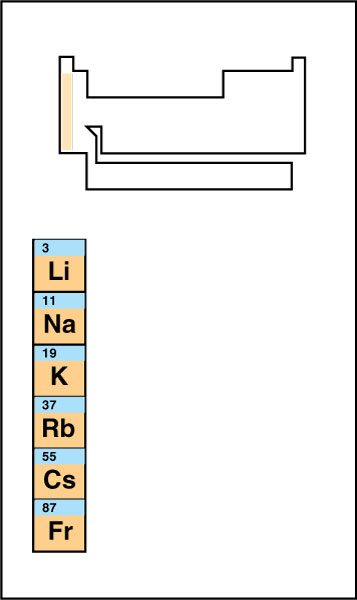Element, Chemical, is any substance that contains only one kind of atom. All chemical substances are elements or compounds (combinations of elements). For example, hydrogen and oxygen are elements, and water is a compound of hydrogen and oxygen. Oxygen and silicon are the most plentiful elements in Earth’s crust, accounting for about 47 percent and 28 percent of the crust’s mass (amount of matter), respectively.
The International Union of Pure and Applied Chemistry (IUPAC) is the recognized authority in crediting the discovery of elements and assigning names to them. For a discovery to be recognized by IUPAC, scientists must produce a sample of the element and measure certain of its properties. In addition, IUPAC prefers that another experiment confirm the discovery. IUPAC recognizes the existence of 118 elements.
Names and symbols of elements
The names of some elements come from Greek or Latin words. Bromine, for example, comes from the Greek word for stench (foul odor). Many elements are named for a place or an individual. Scientists at the University of California at Berkeley produced two new elements and named them berkelium and californium in honor of that city and state. Einsteinium was named for the German-born American physicist Albert Einstein. Traditionally, the scientific community has granted the discoverer of an element the right to name it, subject to acceptance by IUPAC.
Each named element has a chemical symbol consisting of one or two letters. In some cases, the symbol is the first letter of the name. For example, C is the symbol for carbon. If the first letter is already the symbol for another element, another letter of the name is used with the first. For instance, calcium has the symbol Ca. Some symbols come from an old name of the element. The symbol for lead, Pb, comes from plumbum, the Latin word for lead.
Chemists use symbols to write formulas for compounds. Formulas tell which elements and how many atoms of each are in a compound. See Compound.
Discovery of elements
Ancient people recognized the unique properties of a few substances that were later determined to be elements. Among the first of those were gold, copper, carbon, and sulfur. Small amounts of those elements occur naturally in pure, or nearly pure, form. As people discovered how to obtain pure metals from compounds, iron, lead, silver, tin, and other elements came to be known.
From the 1500’s to the 1700’s, experimenters discovered a few elements. The number of known elements began to increase rapidly in the mid-1700’s. But even then, scientists had difficulty determining whether certain substances were elements or compounds. In the late 1700’s, the French chemist Antoine Lavoisier created a system for classifying the known elements. But his list still included many compounds.

The Russian chemist Dmitri Mendeleev developed what scholars widely consider to be the first modern periodic table, published In 1869. He arranged the elements primarily in order of increasing mass but switched the order of some elements on the basis of their chemical properties. He also intentionally left gaps in his table where no known elements seemed to fit. Based on the table, Mendeleev predicted the properties of three unknown elements, which were discovered between 1875 and 1886. Around the same time that Mendeleev created his table, the German chemist Julius Lothar Meyer independently developed a similar periodic table. However, his table was not published until 1870.
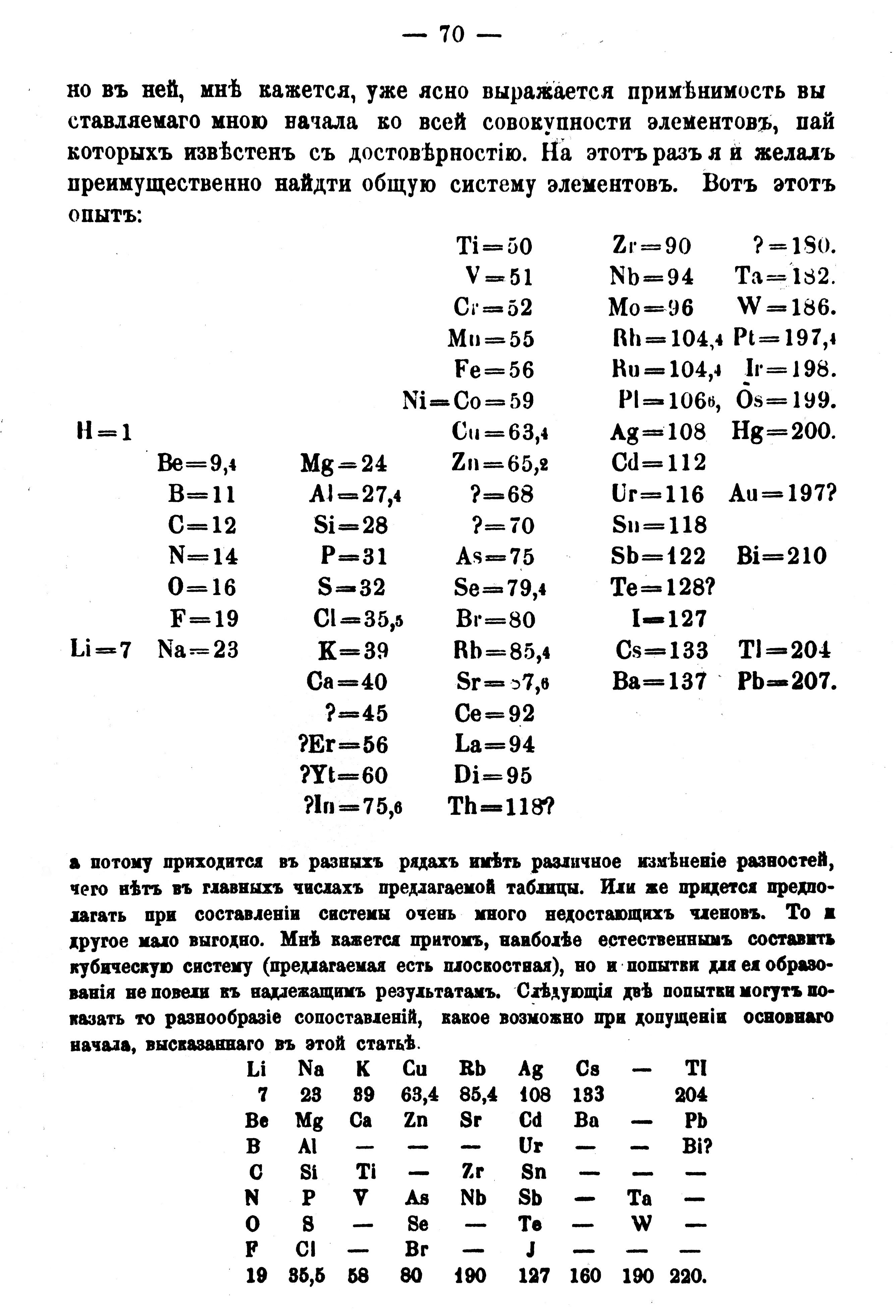
Ninety-three of the elements with atomic numbers 1 through 94 occur naturally on Earth. The exception is promethium—but some scientists think it may exist on Earth in trace amounts, and astronomers have detected it in a star. An atom’s atomic number is the number of protons (positively charged particles) in its nucleus. All atoms of a given element have the same number of protons. Scientists produced most of the remaining recognized elements and elements 113 through 118 in machines called particle accelerators.
Researchers also first discovered neptunium, plutonium, and technetium as a result of accelerator experiments. Later, scientists found tiny amounts of those three elements that had been produced naturally on Earth. Elements are also created in nuclear reactors and the debris of nuclear explosions. See Particle accelerator.
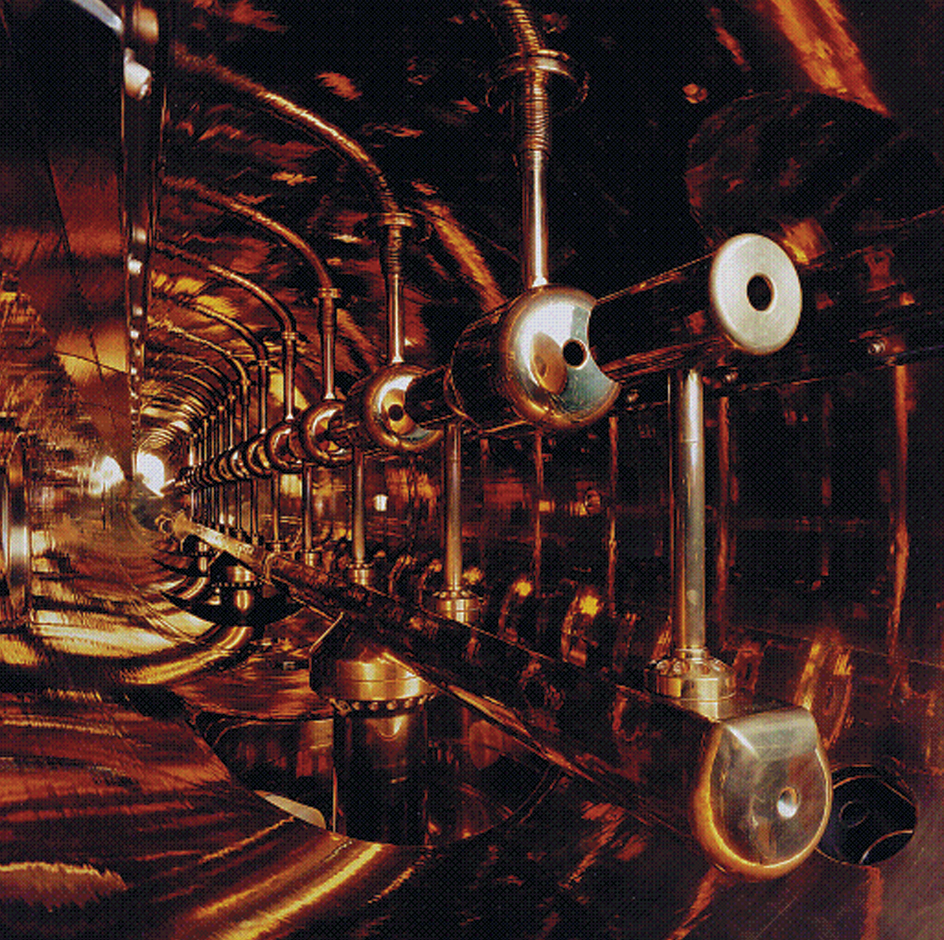
The periodic table of the elements
The periodic table lists the elements in horizontal rows, called periods, in order of increasing atomic number. Elements that have similar properties lie in vertical columns called groups. The table also lists a mass for each element and the numbers of electrons in its electron shells, layers at various distances from the nucleus where the positively charged nucleus holds the negatively charged electrons according to how much energy they have. In addition, the table indicates major classes of elements. For example, a class called the transition metals consists of metallic elements with some common chemical and physical properties.
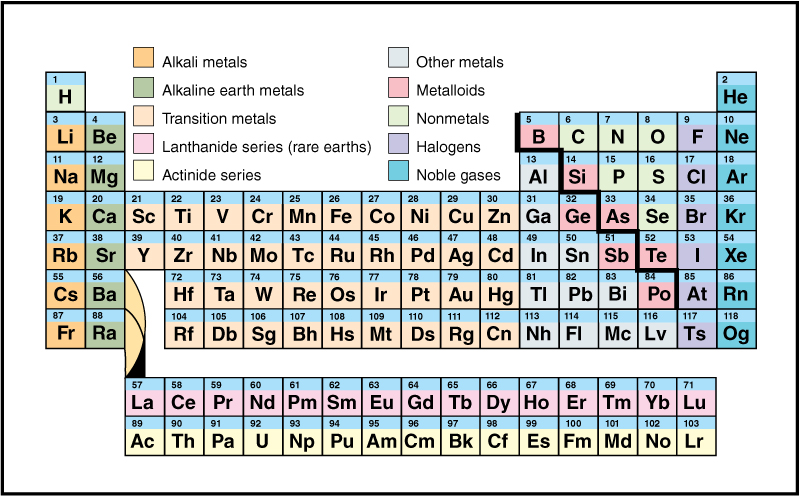
Some of the mass listings are atomic mass numbers, while others are relative atomic masses. To understand those listings and the electron shell listings, you need to know about the structure of atoms and a process known as radioactive decay. An atom consists of a tiny positively charged nucleus surrounded by one or more negatively charged electrons. The nucleus of the simplest kind of hydrogen atom consists of a single proton. The nucleus of every other kind of atom has one or more protons and one or more electrically neutral particles called neutrons.
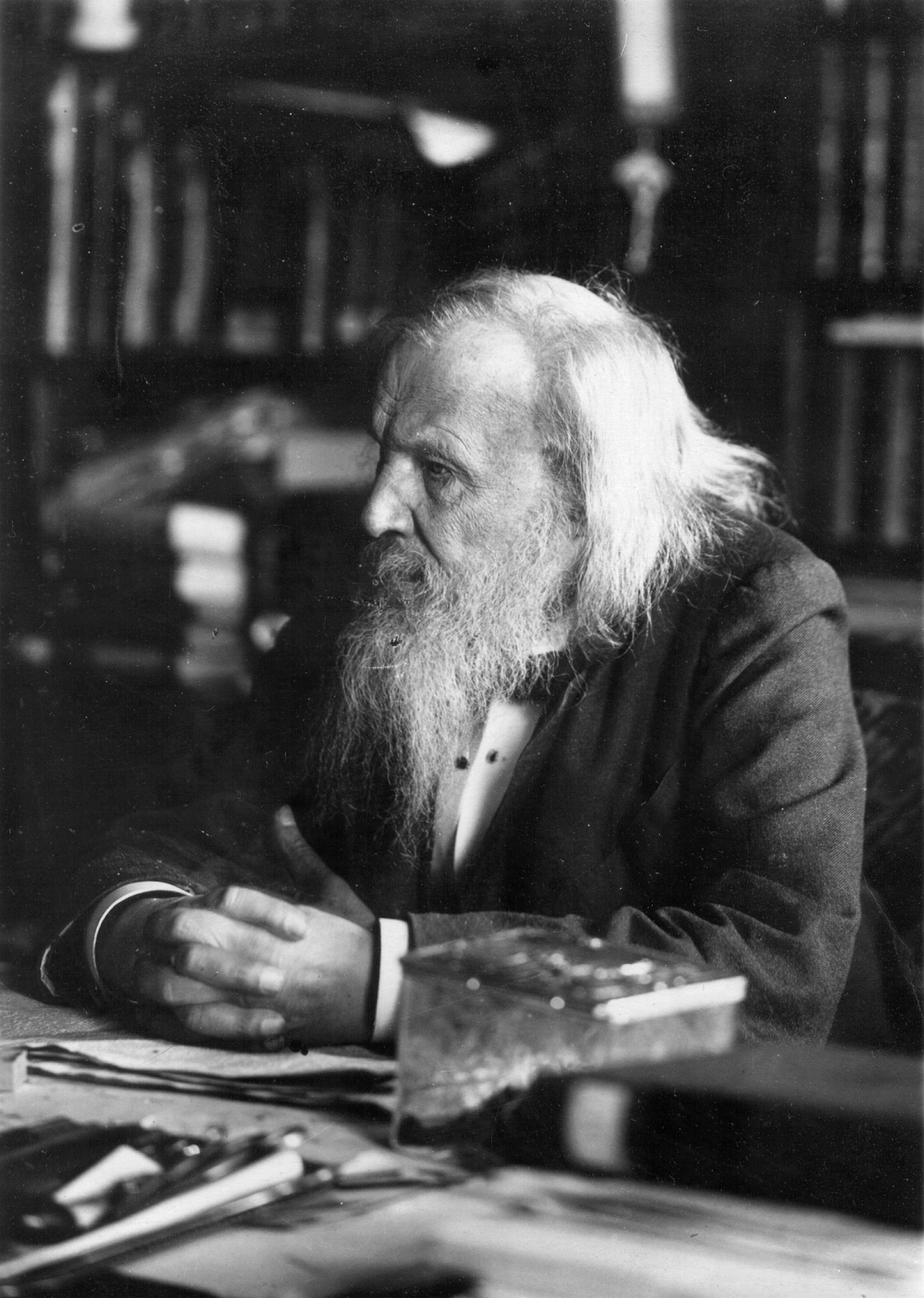
Most elements have more than one atomic form. The different forms have the same number of protons but different numbers of neutrons. Each form of an element is known as an isotope of that element.
Radioactive decay is a process in which one isotope turns into another. There are several forms of this process. In each, there is a change in the isotope’s number of protons, number of neutrons, or both. Because the number of protons distinguishes one element from another, any change in the number of protons produces a different element. Such a change is called a transmutation.
An isotope that might decay is considered to be unstable. A stable isotope cannot decay. Of the recognized elements, 81 have one or more stable isotopes. The remaining elements have only unstable isotopes.
Different isotopes decay at different rates. The rate at which a given isotope decays is that isotope’s half-life—the time taken for half the atoms in a sample of that isotope to decay. Half-lives vary tremendously. The half-life of meitnerium 268 is less than 1/10 of a second; the half-life of uranium 238 is almost 41/2 billion years.
To determine the half-life of an isotope, scientists measure the decay times of many atoms of that isotope. But when scientists have used particle accelerators to create isotopes of the heaviest elements in the periodic table—heavier than element 106, seaborgium—they have often produced only a few atoms of those isotopes. Those atoms and their decays have been detected one at a time. As a result, scientists do not express the stability of such isotopes in terms of half-life. Instead, they state the time between the creation of the isotope and its decay. They may give the value for a single atom or a range—or an average value—for all the atoms.
Atomic mass number.
An isotope’s atomic mass number is the total number of protons and neutrons in its nucleus. Chemists commonly designate an isotope by the name of the element followed by the isotope’s atomic mass number. Thus, copper 63 is an isotope of copper whose atomic mass number is 63. An atom of that isotope has 29 protons and 34 neutrons in its nucleus.
Relative atomic mass
is the ratio of the mass of an isotope or an element to 1/12 of the mass of an atom of carbon 12, the most abundant form of carbon. Thus, carbon 12 serves as a mass standard for all other isotopes. An older term for relative atomic mass is atomic weight.
For an element with only one stable isotope, the relative atomic mass equals the mass of that isotope divided by 1/12 of the mass of carbon 12. For an element with two or more stable isotopes, the relative atomic mass is an average value. That value depends on two factors: (1) the masses of the stable isotopes and (2) the proportions in which those isotopes occur in nature.
For example, copper 63 and copper 65 are the only stable isotopes of that metal. Of the copper in nature, 69.17 percent is copper 63, which has a relative atomic mass of 62.93. The remaining 30.83 percent is copper 65, with a relative atomic mass of 64.93. The calculation for the relative atomic mass of copper is (62.93 X 0.6917) + (64.93 X 0.3083) = 63.55. In this sample calculation, the values are rounded to four digits, and so the answer is approximate. The precise value listed in the periodic table is 63.546.
The periodic table lists the relative atomic mass of each of the 81 elements that have at least one stable isotope. Of the elements with only unstable isotopes, thorium, protactinium, and uranium are most like elements with stable isotopes. Those three elements are plentiful in nature and have isotopes with very long half-lives. As a result, the periodic table also lists the average relative atomic masses of the three. The table lists atomic mass numbers for the remaining elements that have only unstable isotopes. In each case, the number listed is the atomic mass number of the isotope with the longest half-life.
Groups.
Each column in the periodic table lists a group of elements that have similar chemical behavior—that is, they behave somewhat alike in forming compounds. Each group has a number from 1 to 18. The groups include the elements that were created only in particle accelerators. However, scientists have not formed compounds with all those elements, so their chemical behavior is not always well-known.
Electron shells.
The similar behavior of the elements in a group results from a similarity in the structure of their atoms. An electrically balanced atom has the same number of electrons as there are protons in the atomic nucleus. The electrons are arranged in levels called electron shells, according to how much energy the electrons have. Generally, those closest to the nucleus have the least energy. When an electron absorbs energy, it either moves to a higher-energy shell or leaves the atom. The electrons in an atom’s outer shells need to absorb the least energy to leave the atom.
Chemical reactions involve the movement of electrons between atoms or a sharing of electrons by atoms. Thus, the electrons in an atom’s outer shells control the chemical behavior of the atom. In most groups in the periodic table, the elements have the same number of electrons in their outer shells.
Each electron shell has a number. The shell closest to the nucleus is shell 1. Each shell can hold only a certain quantity of electrons. Shells 1, 2, 3, 4, 5, 6, and 7 can hold, respectively, a maximum of 2, 8, 18, 32, 50, 72, and 98 electrons. However, no element has even five full shells because electrons tend to move to outer shells before the inner shells are full. The seven shells are sometimes called the K, L, M, N, O, P, and Q shells.
Classes.
The periodic table uses colors to indicate classes of elements that have similar properties. For example, the table might use a certain color for the noble gases, gases that do not combine readily with other elements. For information about classes of elements, see Actinide; Alkali metal; Lanthanide; Metal; Metalloid; Noble gas; Rare earth.
